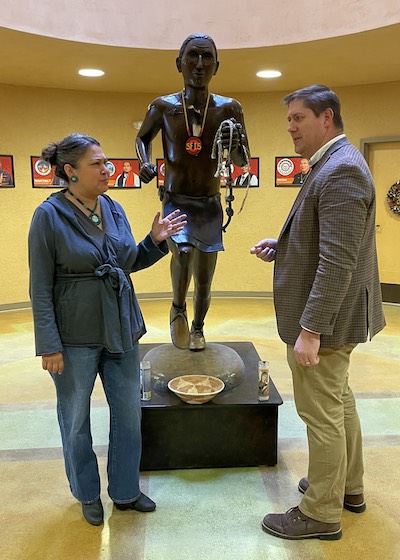
- Details
- By Chez Oxendine
- Economic Development
When it comes to tribal broadband projects, Phoebe Suina knows that every mile of buried fiber can involve securing lots of permits — sometimes from two, three, or more federal agencies, as well local and tribal authorities.
Her company, High Watermark, is in the process of completing an environmental study for the Pueblo Education Network, a Santa Fe Indian School broadband project funded by the National Telecommunications and Information Administration (NTIA) Tribal Broadband Connectivity Program (TBCP). So far, Suina’s work has involved permitting work through NTIA, the Bureau of Indian Affairs (BIA), the Bureau of Land Management (BLM), U.S. Forestry Service (USFS), National Parks Service (NPS) and the U.S. Department of Agriculture (USDA), among others.
“It's quite an alphabet soup in terms of making sure we comply with a whole host of federal requirements,” Suina said. “Each one is unique too, like how local agency staff view their responsibility and their adherence to federal requirements.”
The Pueblo Educational Network, funded by $58 million from the TBCP, will touch 19 surrounding pueblos across 324 miles. That’s a lot of miles and a lot of paperwork, but the project has an edge in streamlining all the permitting as the first-ever tribal project supported by a federal program called FAST-41.
The program grew out of the Fixing America’s Surface Transportation Act, or FAST Act, which was signed into law by then President Barack Obama in 2015. Under a subsequent program — FAST-41 — the Federal Permitting Improvement Steering Council, a federal agency, has aimed to both improve the transparency and speed of the federal environmental review and authorization processes for large-scale infrastructure projects. In 2022, the program began accepting tribally-sponsored projects and removed an onerous $200 million minimum investment requirement for projects.
The FAST-41 program aims to steer multi-agency, multi-government cooperation necessary to move a complex, comprehensive like a broadband buildout forward.
The program doesn’t issue permits itself, but rather serves as an intermediary between the array of agencies involved in any given FAST-41 supported project. That can involve organizing everything from meetings to providing an easily-accessible suite of information for all involved groups.
For the Pueblo Education Network’s current timeline, that means permitting should be complete by 2025, thanks to the program’s technical assistance and team-focused efforts on organizing permitting and interagency work.
“[Broadband infrastructure] has a critical need for this area, and when we were there talking with folks at the school, it's amazing what this project is going to enable them to do,” said Federal Permitting Council Executive Director Eric Beightel. “We're right smack in the middle of that process of moving them forward.”

“That's where that FAST-41 permitting opportunity has really helped us,” Suina said. “It's kind of a misnomer — it's not necessarily fast — but that we do have clarity.”
Santa Fe Indian School Technical Director Kimball Sekaquaptewa reached out to bring the project under FAST-41 after researching the program, she told Tribal Business News. For a project like the Pueblo Educational Network, which involves a lot of middle-mile fiber installation, FAST-41 made sense. Sekaquaptewa believes the program could support other tribal broadband projects also focused on middle-mile, backbone build outs.
“If they're a last-mile project, like fiber to the home, and they have buried utilities, they don’t need this program,” Sekaquaptewa said. “But for the middle-mile projects, and the projects that cross multiple jurisdictions, then that's where this program is really important.”
More tribal projects could stand to benefit from FAST-41’s mix of technical assistance and agency organization, Beightel said.
“We are very much interested in bringing more tribal projects onto the dashboard,” Beightel said. “I think we provide a lot of value-add to projects that may not have the sort of support and technical assistance that other projects do.”
The program’s resources range from providing liaison services at a headquarters level to financing more staff for an agency struggling to keep up with response times in a particularly heady endeavor.
“It’s very technical and nuanced, but at a high level, we bring together agencies and move the project forward,” Beightel said. “There are various strategies that we can deploy that can help these agencies be more timely in their responses.”
The Federal Permitting Council has a funding opportunity for federally recognized tribes wishing to pull projects under the FAST-41 banner, or secure support for environmental review processes like the one currently being undertaken by the Pueblo Educational Network. Maximum funding for those reviews tops out at $300,000, with an additional maximum of $45,000 for contract support costs.
